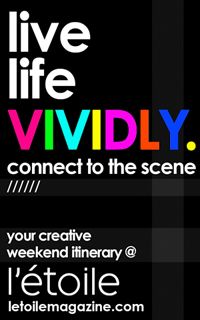On the November 18th, Third Thursdays will unveil the products of a design challenge poised to pair four local fashion designers with works from Minneapolis Institute of Art's extensive trove. Inspired by the pieces' artistic aesthetic
 and cultural elements, the designers have created looks that bring their visionary juxtaposition with art and fashion to life via a stylishly eccentric gala runway show. Prior to the event, l'étoile will be featuring a short Q&A section where readers not only get an insider's perspective on the designers' specific art choices but also catch a sneak preview of their wearable “works of art” collection. (photo of Laura by Marshall Franklin Long)
and cultural elements, the designers have created looks that bring their visionary juxtaposition with art and fashion to life via a stylishly eccentric gala runway show. Prior to the event, l'étoile will be featuring a short Q&A section where readers not only get an insider's perspective on the designers' specific art choices but also catch a sneak preview of their wearable “works of art” collection. (photo of Laura by Marshall Franklin Long) This week, we went behind the sewing machine with sculptress and fashion designer, Laura Fulk, as she talks about her personal connection to photography and how she plans to bring her clothing collection to life.
l'étoile: As fashion inspiration you choose pieces by photographer and electrical engineer pioneer, Harold Edgerton. What drew you to his work?
Fulk: I was a partial photo major in my undergrad and was always drawn to his work. I still get a little star struck to think that the MIA owns it here, in Minneapolis. I think generally even the average person would think his work is astounding. What he’s done – especially during his era – was ground breaking and it’s flat out bizarre to see time frozen in such a way. I'm excited to put that "frozen explosion" in to a garment that moves...and breathes.
l'étoile: Edgerton was credited for his contribution transforming the lab instrument, the stroboscope (aka the strobe). Do you have any plans to execute this concept of oscillation and cyclical motion in the collection you're showcasing?
Fulk: Initially I did, yes. As the concept and actual pieces developed it started to become more about “the era” and the physical act of “blowing up.” I did a similar series in my art school days by blowing up jackets with firecrackers.
l'étoile: These particular photographs feature a sort of severed disconnectedness, an aesthetic that reminds us of some of the dramatic collars and spliced geometric shapes your past garments have incorporated. Is this something you thought of when selecting Edgerton's photographs?
Fulk: Absolutely. There was so much visual beauty in his work it almost takes my breath away. It’s really something when you can create physical reactions through art/fashion such as a “gasp”. That’s what makes me do what I do.
For more info on Third Thursdays at the MIA on November 18th click HERE.
For more info on Laura Fulk click HERE.











